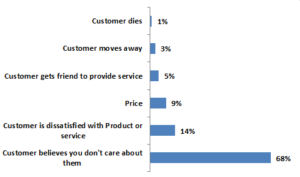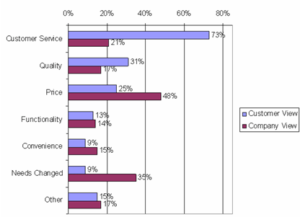 Businesses spend a lot of time and money figuring out how to attract new customers to their product or service. But less thought is given to customers who stop buying and simply leave.
Businesses spend a lot of time and money figuring out how to attract new customers to their product or service. But less thought is given to customers who stop buying and simply leave.
Customers leave for various reasons. And it’s not always easy to pick out the exact reason why they leave. When you ask, they may give a variety of excuses but those may not be the real reasons.
Statistics, depicted in Figure 1 and Figure 2, tell us the major reasons why customers leave.
Figure 1

Quite simply and clearly, the bar graph above shows that 68% of customers leave because they have the perception that the company does not care about them. 14% leave because they are dissatisfied with product or service while only 9% leave because of price. Expectedly, there are a few factors that are not within your control, like when a customer dies or moves away but those constitute only a small percentage of the reasons why customers leave.
So, all together, 91% of the reasons why customers leave are potentially within the company’s control.
Now these are not hard issues to address – but as will be seen in figure 2 below, most companies don’t recognize them as issues.
Figure 2

Figure 2 above shows that a staggering 73% of customers leave because they are dissatisfied with customer service, but the company losing the customer thinks only 21% leave because of customer service – look at the purple bar underneath.
Again, the company losing the customer thinks 48% leave because of price, when in fact only 25% do so. Also, look at the difference in views regarding the impression that customer’s needs have changed – company thinks 35% leave because their needs have changed but customer thinks it’s 9% that leave because of that reason.
What this clearly demonstrates is that the businesses tend to place the reasons (why customers leave) firmly at the feet of the customers (i.e. something outside the business’s control). It’s easier to rationalize a customer’s decision to leave by blaming it on cost, needs change, etc. but, as statistics have shown, often times it’s primarily because we didn’t care about our customers. In other words, we did not treat them well – poor customer service.
Treating customers well requires great attitude and good customer service skills. Do your employees have them? If they don’t and you’re not encouraging them to change, then, as statistics have shown, you’re ignoring a key area that helps to reduce customer defection.
And there’s a strong correlation between defection and profitability. Depending on the industry, reducing your customer defection rate by 5% can increase your profitability by 25 to 125%.